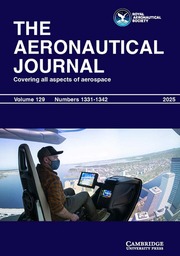Article contents
The verification of a theoreticalhelicopter rotor blade sailing method by means ofwindtunnel testing
Published online by Cambridge University Press: 04 July 2016
Extract
The performance of a helicopter rotor has always beendogged by the dissymmetry of air velocity over theblades caused by its translation in a directionsubstantially parallel to the plane of the rotordisc. Furthermore, in order to make the rotor evenusable, this dissymmetry of lift has caused theintroduction of major mechanical complications tothe rotor hub. In forward flight the rotor isaerodynamically split into two halves either side ofthe flight direction. The advancing side, where therotor rotation is in the same sense as the forwardvelocity, will see a greater dynamic head than theretreating side, where the rotor rotation andforward speed are in opposition. A rigid rotor wouldconsequently suffer a major rolling moment and if aviable proposition is to be achieved the rollingmoment must be avoided.
Information
- Type
- Research Article
- Information
- Copyright
- Copyright © Royal Aeronautical Society 1995
References
- 12
- Cited by

